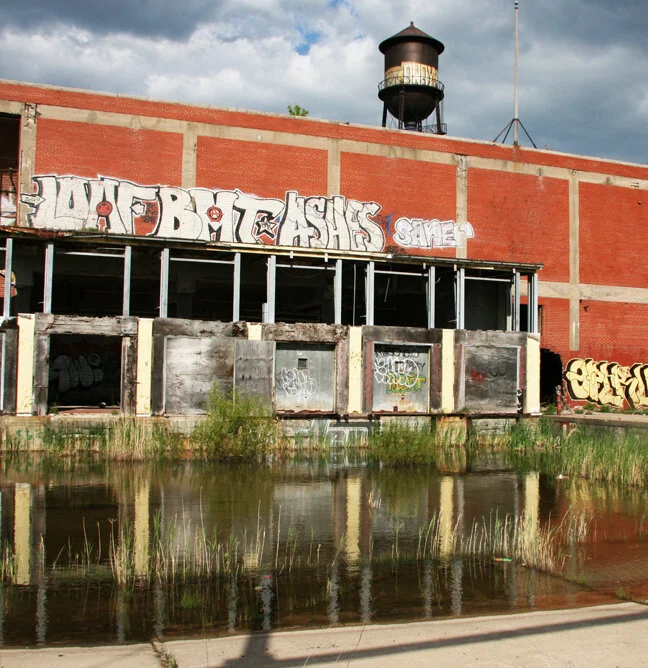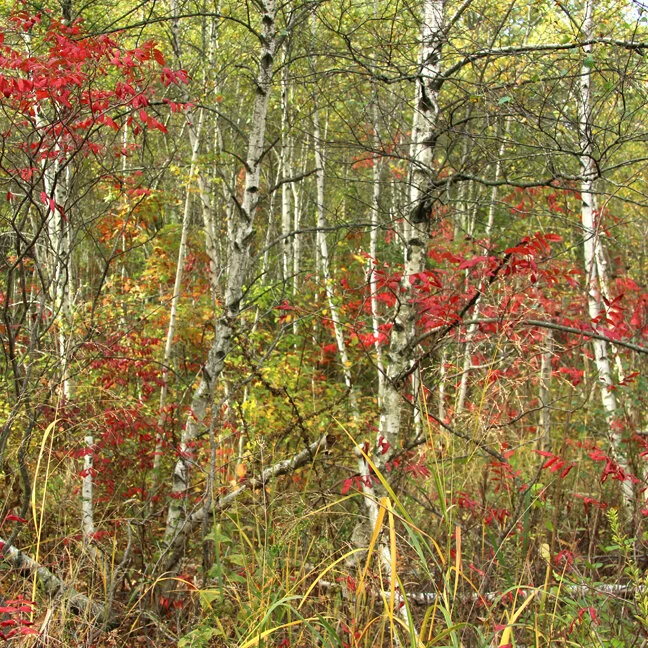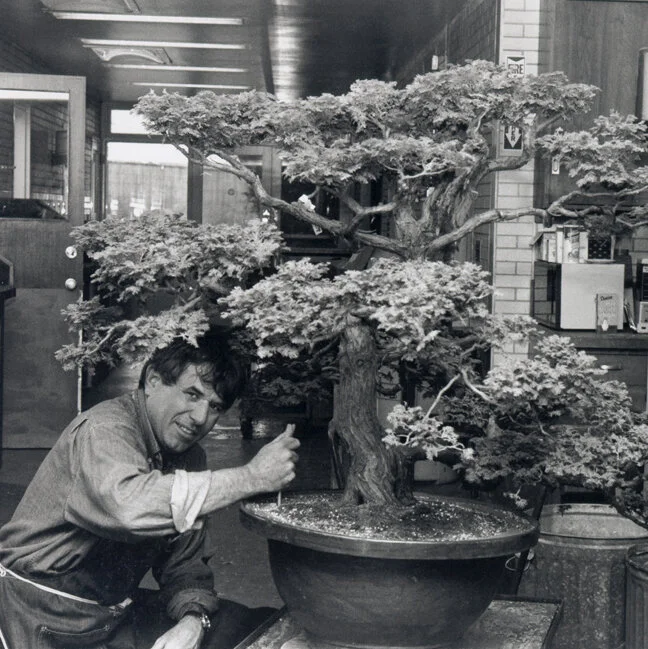
Research & Publications
Over the course of my 48 year career with plants, I have done research on a wide variety of trees, shrubs, and vines native to New England, the Carolinas, California, China, Korea, and Japan as well as the cosmopolitan vegetation that grows in our cities. Since 1974, I have published over two hundred articles on a host of botanical, ecological, and horticultural subjects. What follows is a brief description of the main areas of my research along with a selection of articles I have published in each area.
My research with woody plants began in 1972 and is still going strong.
Urban Ecology
Urban ecology can be distinguished from its natural systems counterpart by the inseparable blend of human culture and natural history. Mastering the discipline requires dealing not only with issues related to the quality of air, water, soil, and climate as modified by people, but also with the complex economic, social, and cultural systems which dictate how energy, raw materials, and technology flow through metropolitan areas. My research focuses on spontaneous urban vegetation—those plants that grow without any human care—and the role they play in making urban areas more livable for humans and non-human alike.
Amnesty for Plants; Boston Globe op-ed, 4 Nov. 2017 (PDF)
Urban Nature — Human Nature; from Living in the Anthropocene, pp. 58-61, 2017 (Smithsonian Books) (PDF)
The Flora of the Future; from Projective Ecologies, pp. 198-217, 2014 (PDF)
Spontaneous Urban Vegetation: Reflections of Change in a Globalized World; Nature and Culture 5(3): 299-315, 2010 (PDF)
Other Order: Sound Walk for an Urban Wild (with Teri Rueb); Arnoldia, 75(1): 14-25, 2017 (PDF)
Green Blacktop; from New Geographies, pp. 198-217, 2011 (PDF)
Read an interview with Peter Del Tredici from Scenerio Journal (spring 2012): “Just a bunch of weeds”
Peter presenting Urban Wilds: Ecolgy in the Real World at a meeting of the New Jersey chapter of the American Society of Landscape Architects in Atlantic City in Feb. 2016 (19 minutes)
Peter Del Tredici photographing pineapple weed (Matricaria discoidea) in Berlin in 2010. Photo by S. Klaw
Loading dock wetland in Detroit.
Oriental bittersweet in Boston.
Peter presenting a talk at a Cultural Landscape Foundation Symposium in San Francisco on May 11, 2015 (35 minutes)
History and Introduction of Invasive Species
Where did the invasive species that everyone loves to hate come from? How and when did they become so widespread in the environment? What were the people who first brought these plants to America thinking? This research demonstraes that the problem of invasive species is as much sociological as it is biological.
Don’t Judge Species on Their Origin (with M. Davis et al.); Nature 474: 153-154, 2011 (PDF)
The Introduction of Japanese Plants into North America; The Botanical Review 83: 215-252, 2017 (PDF)
The Introduction of Japanese Knotweed, Reynoutria japonica, into North America; Journal of the Torrey Botanical Society 144(4): 406-416 (PDF)
Untangling the Twisted Tale of Oriental Bittersweet; Arnoldia 71(3): 2-18, 2014 (PDF)
Peter Del Tredici in the New Jersey Meadowlands in 2014.
Oriental bittersweet (Celastrus orbiculatus)—a botanical boa constrictor.
Japanese knotweed in full flower in August.
Sustainable Horticulture
Everybody talks about sustainability, but what does it really mean? In terms of urban gardening, it means growing plants that are adapted to the prevailing site conditions, will not escape from cultivation and become invasive, and do not require high levels of maintenance in order to thrive. Plants that fit these criteria—regardless of where they come from—are the ones we should be growing in our gardens and cultivating in our public areas.
A Cosmopolitan Urban Meadow for the Northeast; Harvard Design Magazine 37, Spring 2017 (PDF)
The Role of Horticulture in a Changing World; from Botanical Progress, Horticultural Innovations and Cultural Changes, pp. 265-272 (Dumbarton Oaks), 2007 (PDF)
Survival of the Most Adaptable; Arnoldia 60(4): 10-18, 2001 (PDF)
Disturbance Ecology and Symbiosis in Mine Reclamation Design; in Designing the Reclaimed Landscape (A. Berger, ed.), pp. 13-25, 2008 (PDF)
Canada goldenrod and white heath aster in a “cosmopolitan urban meadow.”
The “freedom” lawn in Peter Del Tredici’s front yard.
Spontaneous urban forest in New Jersey.
Resilience (Sprouting) in Trees
This work focuses on species that can sprout back following some form of catastrophic disturbance, be it fire, flooding, hurricanes, tornados, drought, ice storms, animal browsing or logging. From the ecological perspective, these trees are “preadapted” to surviving not only the current onslaughts of urbanization but also the future changes (i.e. rising sea levels) brought on by climate warming.
Sprouting in Temperate Trees: A Morphological and Ecological Review; The Botanical Review 67(2): 121-138, 2001 (PDF)
Aging and Rejuvenation in Trees; Arnoldia 59(4): 10-16, 1999 (PDF)
Redwood Burls—Immortality Underground; Arnoldia 59(3): 14-22, 1999 (PDF)
Shoots from Roots: A Horticultural Review; Arnoldia 55(3): 11-19, 1995 (PDF)
Hibaku Trees of Hiroshima (with H. Tsuchida); Arnoldia 53(3) 24-29, 1993 (PDF)
White mulberry (Morus alba) sprouting back following wind damage.
California bay laurel (Umbellularia californica) sprouting back after the Tubbs fire in Sonoma, CA in 2016.
Silver maple (Acer saccharinum) sprouting back after failed attempts at removal.
Ginkgo biloba Research
I have been studying the Ginkgo tree for thirty plus years and it was the subject of my Ph.D. thesis in 1991. I have travelled to China four times to study the tree in its native habitat and have consulted on its large-scale cultivation for medicinal purposes. I am internationally recognized as an expert on the evolution, ecology and cultivation of the Ginkgo tree.
The Evolution, Ecology and Cultivation of Ginkgo biloba; in Ginkgo biloba (T. A. van Beek, ed.), pp. 7-23, 2000 (PDF)
The Ginkgos of Tian Mu Shan; Conservation Biology 6(2): 202-209, 1992 (PDF)
Where the Wild Ginkgos Grow. Arnoldia 52(4): 2-11, 1992 (PDF)
Natural Regeneration of Ginkgo biloba from Downward Growing Cotyledonary Buds (Basal Chichi); American Journal of Botany 79(5): 522-530, 1992 (PDF)
Wake Up and Smell the Ginkgos; Arnoldia 66(2): 11-21, 2008 (PDF)
Glowing Ginkgos. Silva (Arnold Arboretum): spring 2013 (PDF)
Ginkgo Chichis in Nature, Legend and Cultivation; International Bonsai 15(4): 20-25, 1993 (PDF)
Read a Harvard Magzine article about Peter Del Tredici’s research on the Ginkgo Tree (PDF)
Peter Del Tredici and some of his Chinese colleagues with the largest Ginkgo tree (in terms of girth) on the planet in Guizhou Province, China in 2002. Photo by J. Li
A quadruple row of Ginkgos at peak fall color on Gaiemmae Street in Tokyo in 2012.
The iconic Ginkgo leaf.
Take a walk around the Arnold Arboretum with Peter looking at Ginkgo trees in September 2011 (7 minutes)
American & Asian Hemlocks (Tsuga)
I have been studying hemlock trees since 1981 and my research has covered such topics as the history of Sargent’s weeping hemlock (1983); the immunity of the Chinese hemlock (Tsuga chinensis) to the hemlock woolly adelgid (HWA) (2004); and the description of a newly described Korean hemlock species, Tsuga ulleungensis (2017).
Behind the Scenes on Naming a New Hemlock Species; Arnoldia 76(2): 2-9, 2018 (PDF)
St. George and the Pygmies: The Story of Tsuga canadensis ‘Minuta’ , 1984 (PDF)
Introduction and Cultivation of Chinese Hemlock (Tsuga chinensis) and Its Resistance to Hemlock Woolly Adelgid (Adelges tsugae) (with A. Kitajima), Journal of Arboriculture 30(5): 282-286, 2004 (PDF)
Closing the Book on Sargent’s Weeping Hemlock; Arnoldia 78(2): 8-33 (PDF)
Peter Del Tredici with a mature eastern hemlock (Tsuga canadensis) in Ashville, NC. Photo by P. Meyer
The newly described hemlock, Tsuga ulleungensis, on the island of Ulleungdo, South Korea photographed in 2008
Peter Del Tredici with a mature weeping hemlock in 1980
Stewartia Taxonomy
Stewartias belong to the Camellia Family (Theaceae) and are among the most beautiful trees one can cultivate in a temperate climate. The genus is native to both Asia and eastern North America, a “disjunct” distribution that makes it perfect for biogeographic studies of how plant ranges have shifted over evolutionary time.
Allopatric Speciation in Asia Contributed to the Diversity Anomaly between Eastern Asia and Eastern North America: Evidence from Anchored Phylogenomics of Stewartia (Theaceae) (with J. Li et al.); International Journal of Plant Sciences 180(7): 768-777, 2019 (PDF)
Chinese Stewartia, Stewartia sinensis; Arnoldia 68(2): 59-60, 2010 (PDF)
Stewartia ‘Scarlet Sentinel’; Arnoldia 62(3): 16-22, 2003 (PDF)
Peter Del Tredici with tall Stewartia (Stewartia monadelpha) on Yakushima Island, Japan in October 2012. Photo by T. Kirkham
Peter Del Tredici with mountain Stewartia (Stewartia ovata) in the mountains of South Carolina in June 2009. Photo by J. Johnson
Korean Stewartia (Stewartia pseudocamellia) flowering at Arnold Arboretum.
Asian Plant Exploration
My first foreign plant collecting trip was in 1989 to eastern China to study a wild population of Ginkgo biloba on Tian Mu Shan in Zhejiang Province. Since then I have made seven more trips to China, three to Korea, and three to Japan to study and collect plants in their wild habitats.
The Case for Plant Exploration; Arnoldia 68(2): 3, 2010 (PDF)
The Chinese Parrotia: A Sibling Species of the Persian Parrotia; Arnoldia 66(1): 2-9, 2008 (PDF)
Plant Collecting on Wudang Shan (with P. Meyer et al.); Arnoldia 55(1): 12-20, 1995 (PDF)
Capturing and Cultivating Chosenia; Arnoldia 63(3): 18-27, 2005 (PDF)
The Arnold Arboretum: A Botanical Bridge between the United States and China from 1915 through 1948. Bulletin of the Peabody Museum of Natural History 48(2): 261-268, 2007 (PDF)
Peter Del Tredici with Chinese parrotia (Parrotia subaequalis) on Longwan Shan, Zhejiang Province, China in 2002. Photo by J. Li
Peter Del Tredici on the Chinese – North Korean border in 1997. Photo by P. Meyer
Peter Del Tredici with paperbark maple (Acer grisium) on Wudang Shan, Huberi Province, China in 1994. Photo by P. Meyer
Symbiotic Nitrogen Fixation
My botanical research began in 1972 and involved studying symbiotic nitrogen fixation in sweet fern (Comptonia peregrina) at the Harvard Forest in Petersham, MA. I was part of the team headed by Dr. John Torrey that succeeded in isolating the nitrogen fixing bacteria (Frankia) from the root nodules of Comptonia and growing it in pure culture—groundbreaking research that resulted in the publication of a paper in Science in 1978.
Isolation and Cultivation in vitro of the Actinomycete Causing Root Nodulation in Comptonia (with D. Callaham & J. G. Torrey); Science 199(4331): 899-902, 1978 (PDF)
Method for Growing Plants Aeroponically (with R. W. Zobel); Plant Physiology 57: 344-346, 1976 (PDF)
A Nitrogen Fixation: The Story of the Frankia Symbiosis; Arnoldia 55(4) 26-31, 1996 (PDF)
Bulldozers and Bacteria: The Ecology of Sweet Fern; Arnoldia 56(3): 2-11, 1997 (PDF)
Peter Del Tredici studying root nodules on Australian pine (Casurina equisetifolia) growing in aeroponic culture at the Harvard Forest in 1975.
Close-up of a nitrogen-fixing root nodule on sweet fern (Comptonia peregrina).
Sweet fern (Comptonia peregrina) growing in pure sand on Cape Cod.
The Larz Anderson Bonsai Collection
I served as Curator of the Larz Anderson Bonsai Collection at the Arnold Arboretum from 1982 through 2014. The original plants had been imported into the United States in 1913 and have been in cultivation longer than any other bonsai plants currently growing in North America. The core of the Collection consists of seven large specimens of compact hinoki cypress (Chamaecyparis obtusa ‘Chabo-hiba’) between 160 and 285 years old as well as a number of pine and maple specimens.
Peter Del Tredici repotting an ancient Chabo-hiba hinoki cypress at the Arnold Arboretum.
Compact hinoki cypress (Chamaecyparis obtusa ‘Chabo-hiba’) started in Japan in 1787. In 2006, it was 74 inches wide.
Trident maple (Acer buergerianum) in fall color at Arnold Arboretum, started in 1852. In 2006, it was 34 inches tall.





























